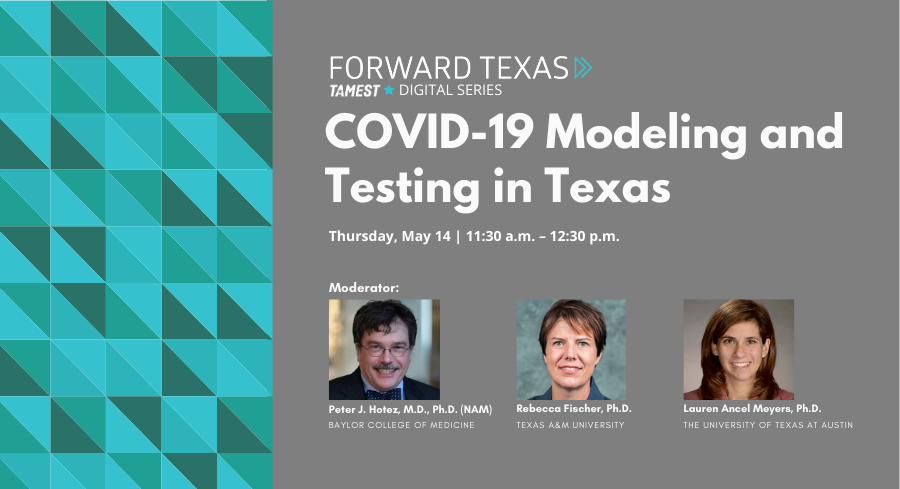TAMEST’s Conversation on COVID-19 Modeling and Testing in Texas
TAMEST members and the greater Texas research community joined vaccine expert and TAMEST Member Peter J. Hotez, M.D., Ph.D. (NAM), Baylor College of Medicine, for a conversation with noted epidemiologists Rebecca Fischer, Ph.D., Texas A&M University, and Lauren Ancel Meyers, Ph.D., The University of Texas at Austin, to explore what the science says the next steps of the pandemic response should be in Texas.
Key takeaways:
- Since Texas municipalities issued stay at home orders early on (in comparison to other states), the state has fared better than most when it comes to infection rates prior to its reopening. However, experts say that as more people leave home, we can expect infections rates to go up.
“I think the big question for us now is: how do we move forward now that there’s been a lot of pressure to open up the economy and to get people back to work and restore some semblance of normal life?” Moderator and TAMEST Member Peter J. Hotez, M.D., Ph.D. (NAM), Dean for the National School of Tropical Medicine, Baylor College of Medicine said. “My big worry is that things are going to sort of move along pretty well for the next few weeks, but then as we head into the summer and fall, we see a big uptick in the number of cases again and the ICUs will start to fill up, especially in our urban centers.”
- Models show that infections will likely reach a peak in Texas by mid-June and that a second wave of the virus is a serious possibility. Experts predict a second lockdown may be necessary to “flatten the curve” of a predicted spike. Community transmission could continue into next year, meaning those most at risk of severe COVID-19 symptoms may have to shelter in place until a vaccine can be found.
“The kind of things we found early on was that this virus was spreading much further and much faster than we originally understood … and people were contagious before they ever felt symptoms and this is what [makes it] so difficult to contain,” Lauren Ancel Meyers, Ph.D., Professor of Integrative Biology, The University of Texas at Austin said. “If we really relax policies in Austin, [models show that] we would see by mid-June hospitalizations that would far exceed our healthcare capacity.”
- With infections increasing as Texas begins to re-open businesses, continued education on mitigating its spread (wearing face coverings, staying six feet away from each other, disinfecting surfaces, etc.) will be more important than ever.
“Those will inform things like how are we safely able to be in a restaurant or a store with individuals. That will inform how business owners approach distancing their employees and sanitizing the facilities,” Rebecca Fischer, Ph.D., Assistant Professor of Epidemiology & Biostatistics, Texas A&M University said. “Fortunately, we’ve learned a lot through this first lockdown. When we first shut things down, we didn’t know any other way … what we’ve now learned is that we have some ways that we can still operate an economy and consumer-based society [by] being creative and exercising caution.”
- The concept of “herd immunity” is unlikely unless we see a much larger spike in cases.
“We don’t actually know if people are immunized after infection, but under an optimistic assumption that they are, data from past pandemics seem to indicate that over 50 percent of our population, in the absence of a vaccine, will have to be infected before this thing starts to dissipate on its own,” Dr. Meyers said. “It’s very likely that very few people have been infected so far, so there’s no silver bullet until we get a vaccine.”
- With a fever only presenting in about 50 percent of COVID-19 cases, testing itself may be the only sure way to screen the public.
“If there is a way to expand testing to make it accessible to everyone, that’s our most valuable tool,” Dr. Fischer said. “Fever screening is not our most useful tool—it’s too labor-intensive, without much benefit. So when we talk about, say, students coming back to live in dorms, how do we do that? I don’t know the answer to that question.”
- Testing numbers alone may not represent an accurate depiction of how many cases exist in our state.
“We don’t use the testing data because it is so confounded by testing effort and testing priority, so it’s really hard to look at the numbers of confirmed cases and see anything reliable as to where it is spreading and how quickly it is spreading, so at this point we cannot use that data reliably,” Dr. Meyers said. “We have found … that in daily hospital admissions and in an unprecedented collaboration in Austin … we have been able to get comprehensive daily numbers of admissions [which gives us a more accurate picture of COVID-19’s spread in our area].”
- In lieu of a vaccine, there is no real cure to this pandemic. The panel of experts advise individuals to take on more personal responsibility and mitigate individual risk.
“Education of [COVID-19 transmission] is going to be really important in anything we do,” Dr. Fischer said.
The video from the conversation on COVID-19 Modeling and Testing in Texas is available here. Visit our website to learn more about our Forward Texas: TAMEST Conversations on COVID-19 series.


